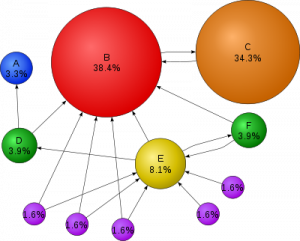This is an introduction to PageRank–a ranking system used on Google and starting to be implemented on other major search engines.
To understand PageRank, you have to understand complex algorithms and the relationship from one website to the next. In my previous post, we discussed a meta tag called rel=nofollow which is used to control and shape PageRank “flow” from one site to another. Now, we’ll go over what PageRank is and why it’s important to make your website stand out above the rest.
PageRank was created by Google co-founder Larry Page and although the name is perfect for what it does, it was actually named after Larry and not a web page. It’s a patented system of assigning weighted values (PR0 through PR10) to a set of hyperlinked documents, or in other words, a website. It’s used to distinguish important websites from less important websites and as you would imagine, the higher your PageRank, the more valuable your site is.
Back in the old days, the success of a search engine was based solely on how many webpages it had in its index. The more sites you can list, the better your results. Today, however, there are just too many sites to manage and it seems that there are at least 100,000 websites for every topic you can imagine. On top of that, the majority of these sites all contain the exact same content. This is because everyone wants a piece of the pie when it comes to making money online, but nobody wants to work for it. Sounds like the real world!
So, Larry Page decided that a search engine shouldn’t be focused on how many sites they can list, but what kind of quality these sites have. Of course, just asking people would be foolish because everyone has a quality site, right? The PageRank feature is such a powerful scoring system and in my opinion it almost encourages development. As an example, my site is a PageRank 2 site and I’m striving to climb up that ranks by providing a 100% original content site and to get backlinks from higher PR sites.
Backlinks
A major part of the PR system is backlinking. This is simply when a website links to your site. The following diagram shows a series of websites. The smaller the circle, the lower the PR score. When a lot of sites link to one site, the circle becomes larger, thus a higher PR score. In the example, Site B has a high PR because a lot of other sites like its content and have linked to it. We’ll discuss Site C in just a bit.

Getting backlinks is not always as easy as it sounds. I can write a whole post on this alone-I just might! Mostly, backlinks come from visitors who view your site, like something on it and link to it from their own site. Alternatively, a lot of webmasters will scour the Internet asking other site owners to trade links with them. One thing to remember is 100 links from 100 PR0 sites is worth far less than 1 link from 1 PR6 site.
PageRank Value
Looking back at the diagram above, you’ll notice that Site C only has one backlink to it, but it’s bigger than Site E which has more incoming links. This is because the one link that Site C has is coming from a high ranking site (Site B). What has happened is because Site B “likes” Site C, it has allowed its own PageRank score to flow into Site C. Of course, Site B doesn’t actually give it’s points away, but it has just told Google that Site C is worth looking at. At first, it seems like this system can be a little unfair, but if you think about it, it really helps to keep quality sites at your fingertips.
When you search for something, you want it fast and you want it right, so how else would we determine which sites get placed at number 1?
There are many resources out there to explain PageRank in much more detail, but I wanted to get you some basic information to help you understand just how important it can be for your site. I will be creating guides on how to get backlinks and to increase your PR score in the near future.